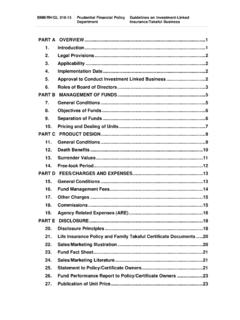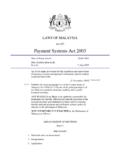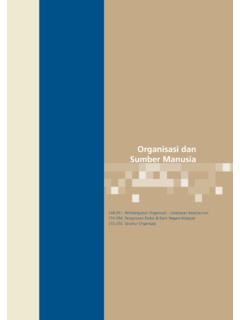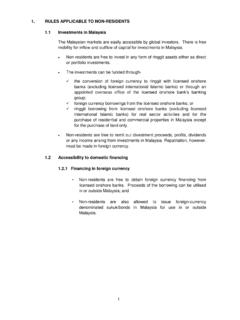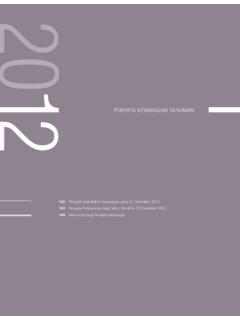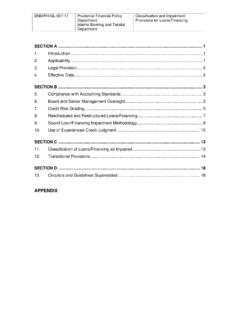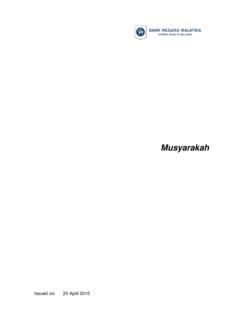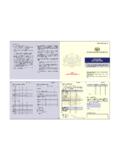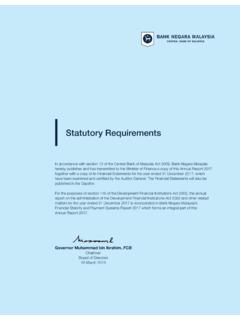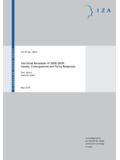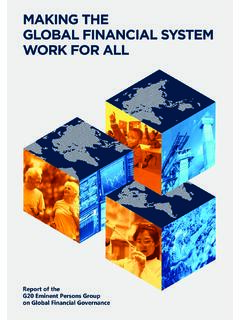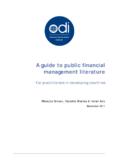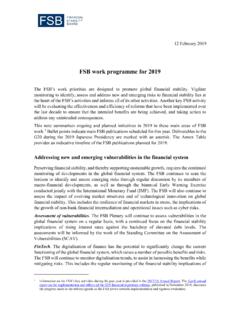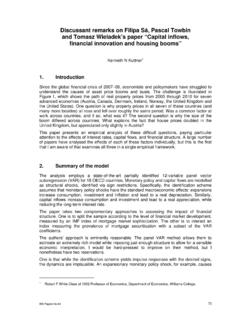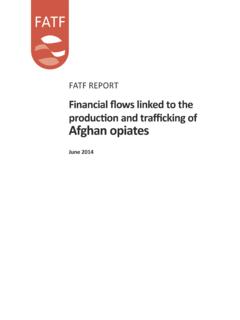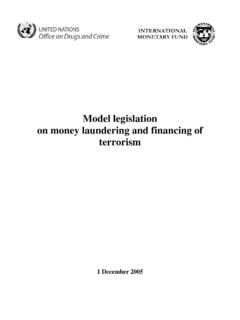Transcription of REGULATORY AND SUPERVISORY FRAMEWORK
1 financial STABILITY AND PAYMENT SYSTEMS REPORT 2012 REGULATORY AND SUPERVISORY FRAMEWORK8789 REGULATORY Developments and SUPERVISORY Assessments90 Box Article: The Legal FRAMEWORK for financial Stability100 Safeguarding the Integrity of the financial System 103 SUPERVISORY Capacity and Cooperation 105 Box Article: Assessment of Malaysia s Compliance with the Basel Core Principles for Effective Banking Supervision109 Box Article: Assessment of Malaysia s Observance of the IAIS Insurance Core PrinciplesREGULATORY AND SUPERVISORY FRAMEWORKFINANCIAL STABILITY AND PAYMENT SYSTEMS REPORT 2012 REGULATORY AND SUPERVISORY FRAMEWORK88 financial STABILITY AND PAYMENT SYSTEMS REPORT 201289 REGULATORY AND SUPERVISORY FRAMEWORKThe REGULATORY and SUPERVISORY FRAMEWORK in Malaysia is now placed on a substantially stronger footing with the recent enactment of key financial services legislation.
2 The financial Services Act 2013 (FSA) and the Islamic financial Services Act 2013 (IFSA), together with related amendments to the Central Bank of Malaysia Act 2009, provide a new and significantly strengthened foundation on which to build and maintain a REGULATORY and SUPERVISORY FRAMEWORK that is effective, transparent and which contributes to an efficient financial system that is resilient to future stresses. More information on the legal FRAMEWORK for the Malaysian financial sector can be found in the box article The Legal FRAMEWORK for financial Stability .Malaysia s REGULATORY and SUPERVISORY system received a positive review from the International Monetary Fund and World Bank under the financial Sector Assessment ProgramThe Bank s REGULATORY priorities continue to be guided by a domestic focus on further raising standards in governance and risk management practices in keeping with the growing scale and sophistication of the activities of financial institutions in and outside Malaysia.
3 A good part of this work included strengthening and updating the prudential rules in line with international REGULATORY reforms, and in consideration of the more developed financial institutions and their growing presence in the region. At the same time, the regional and international dimensions of regulation and supervision continued to feature prominently in the Bank s work. The Bank has also taken an active role in shaping international REGULATORY standards, particularly to ensure emerging market perspectives are taken into account, and in further strengthening its relationships with home and host supervisors of financial institutions in Malaysia.
4 Malaysia s REGULATORY and SUPERVISORY system received a positive review from the International Monetary Fund (IMF) and World Bank under the financial Sector Assessment Program (FSAP). This involved a full evaluation of the Bank s REGULATORY and SUPERVISORY FRAMEWORK for the banking and insurance sectors against international core principles for effective SUPERVISORY systems. The review affirmed the strength and quality of the REGULATORY and SUPERVISORY FRAMEWORK applied in Malaysia, and served to confirm the direction of the Bank s current priorities and initiatives to further strengthen the REGULATORY and SUPERVISORY system. A summary of the assessments and recommendations by the FSAP assessors for banking and insurance supervision is provided in the box articles Assessment of Malaysia s Compliance with the Basel Core Principles for Effective Banking Supervision and Assessment of Malaysia s Observance with the IAIS Insurance Core Principles DEVELOPMENTS AND SUPERVISORY ASSESSMENTS REGULATORY capital and liquidity standards A major step in the domestic implementation of the global REGULATORY reform package relating to the new capital and liquidity standards under Basel III was taken during the year with the publication of final rules by the
5 Bank in November 2012 that will raise the level and quality of REGULATORY capital that banks must hold. Under the new rules, banking institutions are required to maintain high-quality loss-absorbing capital consisting predominantly of Common Equity Tier 1 (CET1), which comprises paid-up capital, retained earnings and disclosed reserves, at 7% of a banking institution s risk-weighted assets, an increase from 2% previously. The new requirements are being phased in from January 2013 to December 2018 in line with globally determined the rules are broadly consistent with Basel III parameters, the Bank has adopted a more prudent approach in some areas.
6 The Bank views this to be appropriate having regard to domestic market conditions and the desire to preserve the strength and quality of capital buffers, particularly in times of stress. The key areas are: (i) requiring significant REGULATORY AND SUPERVISORY FRAMEWORK90 financial STABILITY AND PAYMENT SYSTEMS REPORT 2012 The Legal FRAMEWORK for financial Stability The enactment of the financial Services Act 2013 (FSA) and Islamic financial Services Act 2013 (IFSA), which were approved by Parliament in December 2012, marks another important milestone in modernising Malaysia s fi nancial sector laws. These new laws are the culmination of more than six years of work which started concurrently with the review of the Central Bank of Malaysia Act 1958, and involved a wide-ranging review of the various laws for the regulation and supervision of the fi nancial sector, particularly taking into account important changes that were occurring across the domestic and global fi nancial landscapes.
7 The review and modernisation of Malaysia s fi nancial sector laws ensure that these laws continue to be relevant and effective in preserving fi nancial stability and supporting the growth of the Malaysian fi nancial system and the real economy. Over the decade, the focus of and the approach to fi nancial sector regulation and supervision has evolved substantially, not just in Malaysia but also internationally. As the fi nancial system has become more diverse, more sophisticated and more interconnected, fi nancial regulation has correspondingly evolved from detailed and prescriptive rules to a principles-based approach that combines greater SUPERVISORY judgment and intensity with high-level principles of sound practice that can be applied to institutions according to the nature, scale and complexity of their activities.
8 There has also been a fundamental re-orientation of the focus of fi nancial supervision to take into account system-wide developments and risks, in addition to the traditional focus on individual fi nancial institutions. This has involved a widening of the scope of oversight to include the supervision of fi nancial groups and non-bank fi nancial institutions that engage in fi nancial intermediation activities. Beyond prudential regulation, the other aspects of fi nancial sector regulation such as business conduct regulation that focuses on consumer protection and fi nancial inclusion have also become more prominent, driven by changing demographics, the increasing complexity of fi nancial products and public policy goals to alleviate poverty, improve equity and enhance growth.
9 Another important feature in the development of Malaysia s fi nancial system has been the growing signifi cance and role of Islamic fi nance. The development of a comprehensive legislation for Islamic fi nance has further extended the frontier of fi nancial regulation in Malaysia. These developments have had a signifi cant role in shaping the key statutes which were introduced over the decade and which form part of the legal FRAMEWORK for the fi nancial sector, including the Development financial Institutions Act 2002 (DFIA), Payment Systems Act 2003 (PSA) and the Malaysia Deposit Insurance Corporation Act 2011 (MDICA). The enactment of the new central bank legislation in 2009, the Central Bank of Malaysia Act 2009 (CBA), and the FSA and IFSA in 2013 capped off the series of comprehensive legislative reforms that have been the post 9/11 era, global efforts to combat money laundering and terrorism fi nancing have intensifi ed in response to new political realities and increasingly sophisticated money laundering techniques and methods.
10 Preserving the integrity of the fi nancial system and preventing its abuse for criminal and terrorism purposes became an important agenda of the Government. While Malaysia already had in place a rigorous legislation for these purposes in 2001, the scope of reporting institutions under the Anti-Money Laundering and Anti-Terrorism Financing Act 2001 (AMLATFA) has now been extended to include non-fi nancial institutions to more effectively address money laundering risks in activities that fall outside the fi nancial sector. The AMLATFA also supports more effective collaboration between the Bank, fi nancial institutions and law enforcement agencies in the areas of crime prevention and national security.
